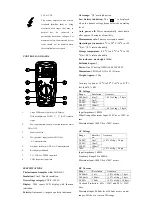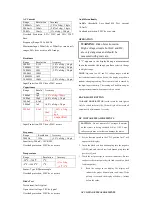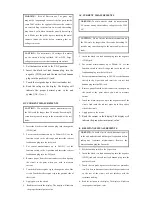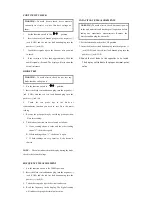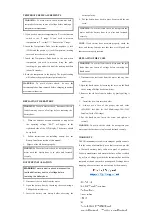
AC Current
Range
Resolution
Accuracy
2.000mA
1uA
+1.2% of rdg + 3 dgts
200.0mA
100uA
+2.0% of rdg + 3 dgts
20.00A
10mA
+3% of rdg + 10 dgts
Overload Protection: 0.2A / 250V and 20A / 250V
Fuse.
Frequency Range: 50 to 400 Hz
Maximum Input: 200mA dc or 200mA ac rms on mA
ranges, 20A dc or ac rms on 20A range.
Resistance
Range
Resolution
Accuracy
200.0
0.1
+1.0% of rdg + 4 dgts
2.000k
1
+1.0% of rdg + 2 dgts
20.00k
10
+1.2% of rdg + 2 dgts
200.0k
100
2.000M
1k
20.00M
10k
+2.0% of rdg + 5 dgts
Input Protection: 250V dc or 250V ac rms.
Capacitance
Range
Resolu
tion
Accuracy
2.000nF
1pF
+4.0% of rdg+70dgts
20.00nF
10pF
+4.0% of rdg + 3 dgts
200.0nF
0.1nF
+4.0% of rdg + 3 dgts
2.000uF
1nF
200.0uF
0.1uF
≤
20uF
+4.0% of rdg +
15
dgts
≥
21uF
unspecified
Input Protection: 250V dc or 250V ac rms.
Frequency
Range
Resolution
Accuracy
2000Hz
1Hz
+1.5% of rdg + 5 dgts
Sensitivity: 200mV~ 10V RMS ;
Overload protection: 250V dc or ac rms.
Temperature
Range
Resolution
Accuracy
-20oC~+760oC
1 oC
+3% of rdg
+5 oC/9 oF
-4 oF~+1400 oF
1oF
Sensor: Type K Thermocouple
Overload protection: 250V dc or ac rms.
Diode Test
Test current: 1mA typical
Open circuit voltage: 2.8V dc typical
Overload protection: 250V dc or ac rms.
Audible continuity
Audible threshold: Less than50
Test current:
<0.3mA
Overload protection: 250V dc or ac rms.
OPERATION
WARNING
: Risk of electrocution.
High-voltage circuits, both AC and DC,
are very dangerous and should be
measured with great care.
If “1” appears in the display during a measurement,
the value exceeds the range you have
selected. Change
to a higher range.
NOTE
: On some low AC and DC voltage ranges, with the
test leads not connected to a device, the display may show a
random, changing reading. This is normal and is caused by
the high-input sensitivity. The reading will stabilize and give
a proper measurement when connected to a circuit.
BACK LIGHT BUTTON
The
BACK LIGHT BUTTON
is used to turn the back light on
Only. To extend the battery life, The back light will be turned off
automatically within around 3 seconds
DC VOLTAGE MEASUREMENTS
CAUTION:
Do not measure DC voltages if a motor
on the circuit is being switched ON or OFF. Large
voltage surges may occur that can damage the meter.
1.
Set the function switch to the V DC position (“mV” will
appear in the display).
2.
Insert the black test lead banana plug into the negative
(COM) jack and the red test lead banana plug into the
positive (V) jack.
3.
Touch the test probe tips to the circuit under test. Be sure
to observe the correct polarity (red lead to positive, black
lead to negative).
4.
Read the voltage in the display. The display will
indicate the proper decimal point and value. If the
polarity is reversed, the display will show (-) minus
before the value.
AC VOLTAGE MEASUREMENTS


